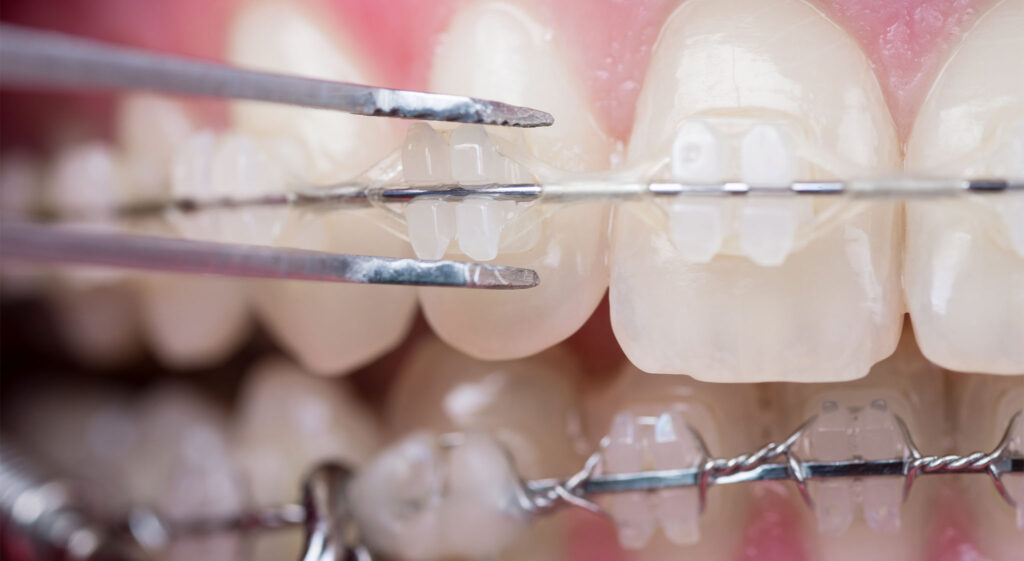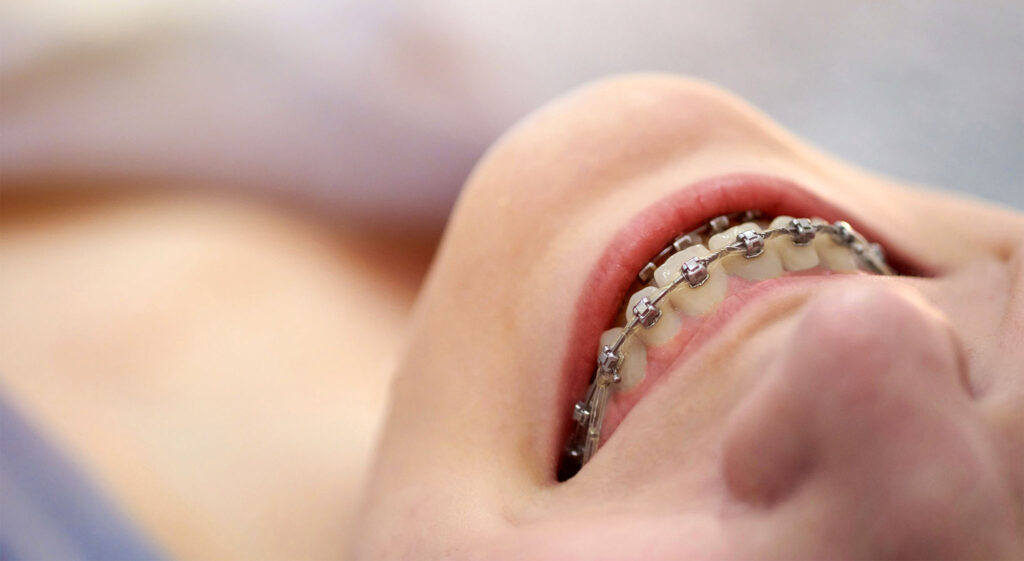Malocclusion, asymmetry of facial contours, misalignment of teeth, and abnormal growth of the face and jaws are common in both young and old patients. Therefore, orthodontic treatment may be required at any age for aesthetic and functional reasons.
What is orthodontic treatment?
An irregular bite is not only an aesthetic problem, but also a serious threat to patient’s health. Often, an irregular position of the jaws and/or teeth leads to impaired diction and makes chewing and eating difficult. The unnatural (increased) stress placed on the teeth, jaw muscles and joints during chewing contributes to premature tooth wear and can lead to persistent head, shoulder or even back pain. In addition, an irregular bite makes it more difficult to clean the teeth, which leads to poor oral hygiene, increased tooth mobility, tooth decay, and gum disease. All of these irregular bite consequences can be avoided by seeking professional orthodontic care.
In general, orthodontics is a specific field of dentistry that aims to diagnose, prevent and correct misaligned teeth and jaws. Orthodontics can also modify the growth of facial bones, thus avoiding orthognathic surgery in the future. It is also important to note that it is not only the position of the teeth and facial bones that changes, but also the soft tissues.
What is the best age to start orthodontic treatment?
Orthodontic treatment can be started either in early mixed bite or permanent bite, depending on the pathology. Often, in the case of a larger anomaly, starting treatment at an early age can lead to better and faster results, but it all depends on the clinical situation.
How does orthodontic treatment work?

Orthodontic diagnostics
Treatment with an orthodontist starts with a thorough examination, during which the patient’s medical history is taken and a clinical examination is performed. Diagnostic tools may include diagnostic models of the patient’s jaws, photographs, X-rays and CT scans. In some cases, additional examination of the jaw joint may be necessary.
In addition, a thorough consultation with the patient is essential before choosing a treatment method, during which the patient’s preferences and lifestyle habits and expectations are discussed. Once the diagnosis has been established and all the parameters of the clinical situation have been professionally assessed, the orthodontist recommends the best treatment option, determines the approximate duration and method of treatment.
Orthodontic treatment methods
The main methods of orthodontic treatment are:
- Common orthodontic treatment – involves the use of various orthodontic appliances (plates, braces, caps, etc.) that are placed on the patient’s teeth to apply constant force to the teeth and jaws and to change the position of the teeth in the dental arch. This treatment also includes orthodontic appliances that modify the growth and development of the jaws.
- Orthodontic treatment and orthognathic surgery – in the case of skeletal deformities, one of the treatment options is orthognathic surgery with both preparatory and finishing stages of orthodontic treatment.
- Camouflage orthodontic treatment – in the case of skeletal deformities and without orthognathic surgery, so-called camouflage treatment can sometimes be carried out to correct the position of the teeth in order to “hide” the irregular position of the jaws.
What is used for orthodontic treatment?

Orthodontic treatment uses a variety of structures and appliances that affect the jaws and teeth in different ways. Nowadays, there is a wide variety of orthodontic appliances that are used to treat both adult and very young patients. This allows the most comfortable and effective treatment method to be selected individually according to the patient’s preferences and clinical situation.
There are two types of orthodontic appliances to correct the position of teeth: fixed and removable. The removable appliance can be taken out during meals, oral hygiene and sometimes overnight, while the fixed appliance remains attached to the teeth for the whole duration of treatment.
Types of orthodontic appliances
Fixed orthodontic appliances
Braces are the most common fixed orthodontic appliances. They consist of brackets, archwires, ligatures, elastic bands and many other components. The brackets are fixed to the teeth with a special adhesive and a metal archwire is inserted into the ‘holes’ in the brackets to connect the brackets together. The wire transmits the pressure to the teeth through the brackets and also allows the teeth to move together until they reach the correct position.
When wearing braces, a visit to the orthodontist is usually required every month. These days, braces are made of a wide range of materials, they are lighter and smaller, and have a simpler design. From simple metal braces to transparent sapphire braces, there is a suitable option for every patient.
“Twin-block appliance – a removable functional appliance for correcting the bite. It consists of two plates, an upper and a lower plate. When the appliance is placed in the mouth, the lower jaw is placed in an anterior position to stimulate growth.
The twin-block appliance is effective for distal occlusion when there is a pronounced asymmetry of the lower face and the upper jaw is positioned far forward. The device is most effective during the period of active jaw formation, i.e., adolescence.
Headgear – also commonly called “orthodontic whiskers” – is used to correct distal occlusion, which is a condition that prevents the growth of the upper jaw. Usually, such a construction requires rings to be placed on the first upper molars. It can be combined with other orthodontic constructions.
A face mask is an orthodontic appliance designed to correct a mesial bite. The growth of the upper jaw is stimulated by wearing the face mask. It is usually combined with a rapid expander screw.
Carriere motion is a state-of-the-art fixed orthodontic appliance designed to treat the mesial bite. It pushes the teeth of the upper jaw backwards and the entire lower jaw forwards. The patient must wear elastics during treatment with this orthodontic appliance.
The Rapid Maxillary Expander (RME) is a fixed orthodontic appliance that allows skeletal expansion of the upper dental arch. It can be fixed on two or more teeth. The treatment duration is from a few weeks to a month, followed by a retention period.
MARPE is a modern orthodontic solution. Mini-implants are an excellent alternative to traditional dental extenders. While RME can be used at an early age, in adolescence, MARPE is also suitable for adults when the upper dental arch needs to be expanded.
“Bollard micro implants are special orthodontic implants used to treat complex cases. “Bollard micro-implants are screwed into the jaw by a surgeon. During orthodontic treatment, these orthodontic appliances are used as rigid additional points of support to push the patient’s teeth or jaws together.
Space maintainers – after the premature loss of milk teeth, it is very important to keep space for permanent teeth. In this situation, removable or fixed appliances are used to prevent space closure. They are used until the permanent tooth/teeth emerge.
A Herbst appliance is an orthodontic appliance used to correct a distal malocclusion, which is an anomaly where the lower row of teeth is significantly deeper than the upper row of teeth. The Herbst appliance consists of two telescopic mechanisms connecting the upper and lower jaw and acting on the lower row of teeth. The appliance has a permanent corrective effect, does not cause significant discomfort and is hardly visible because it is fixed to the lateral teeth. Treatment with the Herbst appliance lasts up to 12 months.
Powerscope is an orthodontic appliance that is also used to treat the distal bite. It is fixed directly onto the orthodontic wire and is smaller than the Herbst appliance. It is a good alternative for patients who do not want to wear elastics.
Removable orthodontic appliances
- Dental plates are removable orthodontic appliances worn on the upper or lower jaw. The plates are made individually for each patient, attached to the teeth by special abutments and activated by special elements. The plates are comfortable to wear and can be removed while eating and brushing. Plates are mainly used for early bite shaping, but are not suitable for complex orthodontic anomalies.
- Dental straightening caps are removable orthodontic appliances made of ultra-thin, clear, soft plastic. The caps are individually made according to digital impressions of the patient’s jaw using 3D technology. They are used to treat a wide range of malocclusions. The duration of treatment depends on the complexity of the condition and ranges from 6 to 24 months. A course of orthodontic treatment may require between 10 and 80 pairs of teeth straightening caps, which must be replaced every two weeks under the supervision of an orthodontist. The aligners are worn for at least 22 hours a day and can be removed while eating and brushing.
Stages of orthodontic treatment
Once the orthodontist has selected the most suitable orthodontic treatment method, the patient undergoes preparatory procedures before starting orthodontic treatment:
- Treatment of diseases of the teeth and gums.
- Tooth extraction if necessary.
- Professional oral hygiene.
Once the mouth and teeth have been prepared for orthodontic treatment, the following main treatment steps are carried out:
- Manufacture and fitting of orthodontic appliances. If treatment requires, all pre-surgical procedures are performed.
- Systematic visits to the clinic for preventive care, correction of braces and professional oral hygiene.
- Once the treatment goal has been achieved, the orthodontist removes the orthodontic appliances.
- Professional oral hygiene and, if necessary, dental and gum treatments.
- Placing retainers to stabilise treatment results. Periodic visits to the orthodontist during the retention period (up to twice a year).
It is important to note that even long-term use of orthodontic appliances does not guarantee that the position of the teeth obtained during orthodontic treatment will remain permanently. Sooner or later, the jaw muscles may return to their original position. Therefore, the application of retainers is a very important and necessary part of orthodontic treatment.
In some cases, orthodontic treatment may be followed by prosthodontics, replacing old restorations and prosthetic structures.
What to consider before starting orthodontic treatment?

It is important to understand that orthodontic treatment is a long-term process, the outcome of which depends largely on the patient’s awareness. Therefore, treatment should be started with patience and a determination to be even more responsible and careful with your oral hygiene, to visit the orthodontist regularly and to follow his/her recommendations strictly.
Orthodontic treatment is a serious and responsible journey, the goal of which is correct occlusion, a harmonious smile, excellent aesthetics and good oral health! After all, it’s not for nothing that people say “smile and the world smiles with you” – and it’s much easier to do that with a beautiful smile 🙂

